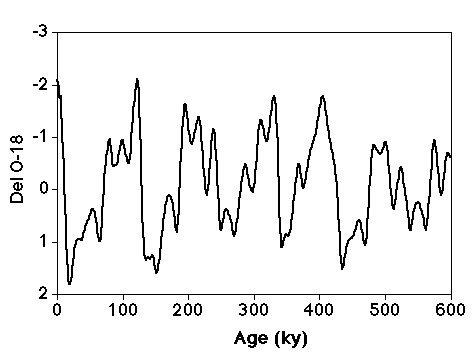
Sediment sequences do not record climatic parameters (temperature, rainfall, atmospheric pressure, P-E, seasonality, etc.) directly. They can only be inferred from proxies which must usually be calibrated empirically against modern data or other geologic variables. The choice of proxies depends on the time interval under consideration. Examples of the proxies that have proved useful in interpreting Pleistocene (last 1.8 million years) climates include:
1. Oxygen isotopic composition of foraminiferal tests. As forams build their tests, the incorporated ratio of 16O to 18O varies over time and space. Oxygen isotope systematics were covered last week, so suffice it to say here that the ratio measured in fossil tests in carbonate sediments varies as a function of:
At most locations, the downcore variation is dominated by the preferential segregation of 16O in continental ice masses; thus, during ice ages when large ice caps built up on North America and Eurasia, the oceans were enriched in 18O. This enrichment affected the entire ocean simultaneously (to within the mixing time of the oceans - about 103 years).
This property of the oxygen isotope record has been used to create a "global standard" chronology (the "SPECMAP stack" - Figure PR-1) which can be use both to correlate oxygen isotope profiles from around the world and to assign "absolute" ages to these profiles.

Figure PR-1. SPECMAP del18O stack for the past 600,000 years.
Figure PR-2 shows the correlation and age scale used by Imbrie et al. (1992) in their assessment of Milankovitch forcing of glacial cycles. Note that the correlations are limited by sampling intervals and variable bioturbation, as well as by the mixing time of the oceans, and that the assigned ages are model dependent.
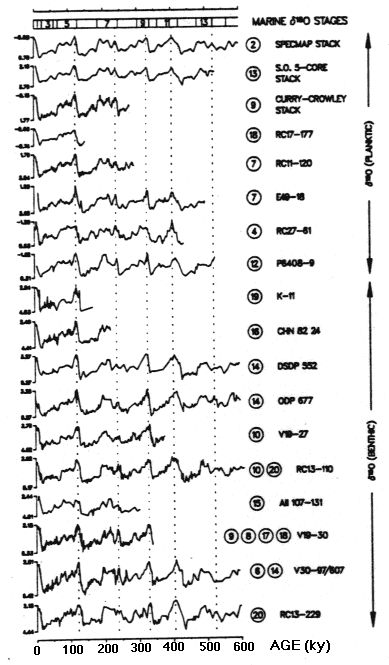
Figure PR-2. SPECMAP data sets correlated by del18O records.
In addition to their correlation and chronology applications, oxygen isotope data are used to infer paleotemperatures (by subtracting the ice-volume part of the signal) and to assess changes in temperature gradients (either vertically or ocean basin to ocean basin) by assuming that the ice-volume signal is identical in contemporaneous samples, so can be subtracted out.
2. Alkanone indices. Haplophyte algae, particularly Emiliania huxleyi, synthesize unsaturated methyl alkenones (unsaturated ketones) with 37 C atoms and 2, 3, or 4 double bonds. These molecules are designated 37:2, 37:3 and 37:4, respectively. All are resistant to degradation in deep-sea sediments.
The proportions of the three molecules are dependent on the temperature of the water in which they are synthesized. Two indices are used:
UK37 = (37:2 - 37:4) / (37:2 + 37:3 + 37:4), and
UK37' = 37:2 / (37:2 + 37:3) (for low latitudes where 37:4 ~ 0)
The indices have been calibrated against temperature using cultures of E. huxleyi from the North Pacific. The relation is linear, i.e.:
UK37 = A + BT, where A and B are empirical constants.
Problems:
3. Relative abundances of species in sea floor sediment samples, which provide insights to the environmental conditions in the overlying water column where the organisms lived. Because the abundances of different species in a suite of samples are found to be correlated, and because counting errors depend on the number of each species present, the raw abundance data normally are transformed and aggregated to yield statistically independent assemblages, each of which can be treated as a single variable. The most common transformation / aggregation procedure is called factor analysis. It involves:
The contribution of the various factors to the samples are found to be related to environmental parameters of the water in which the forams lived.
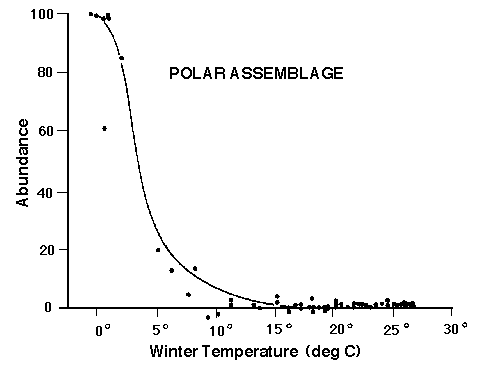
Figure PR-3a. Variation in the abundance of "polar" foraminifera (selected by factor analysis) with winter temperature.
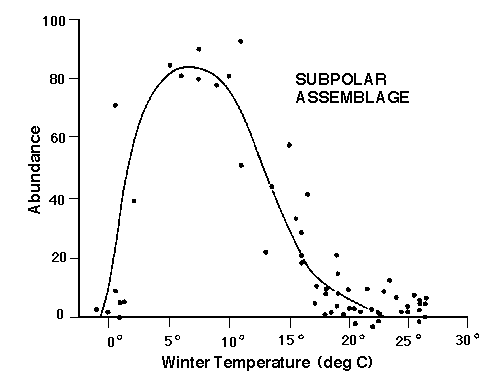
Figure PR-3b. Variation in the abundance of "subpolar" foraminifera (selected by factor analysis) with winter temperature.
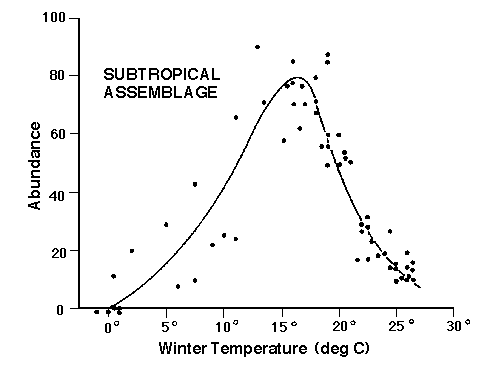
Figure PR-3c. Variation in the abundance of "subtropical" foraminifera (selected by factor analysis) with winter temperature.
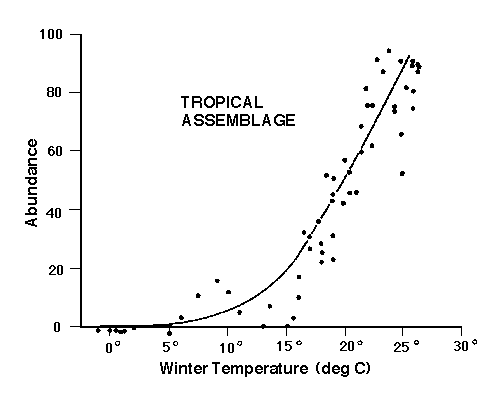
Figure PR-3d. Variation in the abundance of "tropical" foraminifera (selected by factor analysis) with winter temperature.
A regression equation ("transfer function") is then calculated for the environmental parameter of interest (most commonly sea surface temperature - SST) in terms of the factors, their squares and cross products. The error in the temperature estimates (about 2ºC - Figure PR-4) is small relative to the range of variation in SST across the oceans, but is problematic in limited areas.
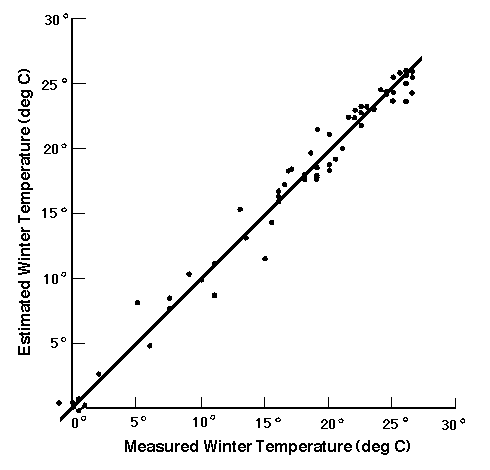
Figure PR-4. Comparison of measured winter temperature and temperature estimated from regression of foram assemblage factors.
NOTE: If the communality is low, there may be no analog to the downcore sample, so the estimated temperature will be suspect. In the eastern equatorial Pacific, this problem led to estimates of the glacial SST that were high relative to estimates from adjacent land areas and groundwater. The problem was addressed by pooling all the surface and downcore samples before factoring, then using only the surface sample to generate a transfer function. The function, when applied to the co-factored downcore samples reduced the glacial SSTs by 2 or more degrees.
When samples are plotted in species space, the angle between them (expressed as cos theta) is a measure of their similarity (cos theta = 1 for identical samples). This leads to an alternate method to estimate paleotemperatures: Downcore samples are compared to the surface set in species space. The paleotemperature is estimated by averaging the temperatures of the most similar 3 or 4 surface samples. If the cos theta values between the downcore and all surface samples are low, a no-analog situation is again indicated.
Figures PR-5 and PR-6 are examples of profiles of paleotemperature generated by the factor analysis /transfer function technique. In each case, the original depth-in-core has been replaced by an age scale based on oxygen isotope correlations with the SPECMAP stack.
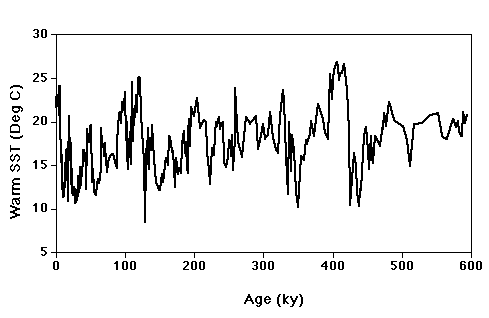
Figure PR-5. This temperature record from core V30-97 spliced to DSDP 607 is derived from planktonic foraminifera from 41º N in the eastern North Atlantic (west of Spain), an area which was crossed repeatedly by the boundary between subarctic and subtropical waters. As a result, the warm-season temperature at the site has varied by more than 15ºC.
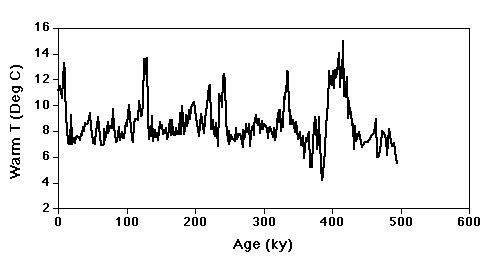
Figure PR-6. This temperature record from core RC11-120 spliced with E49-18 is derived from radiolaria from 44º S in the Southern Ocean (directly south of India), a site which has been south of the Antarctic Convergence for most of its history.
CAUTION: While the use of the transfer function technique has been largely responsible for transforming paleoceanography from a qualitative to a quantitative science, the theoretical basis for the approach is limited. Mathematically, the technique requires that for F factors, there be F-1 or less controlling physical processes. The validity of this assumption can rarely be established. Ecologically, forams and radiolaria live over an extended depth range and secrete their tests over limited seasons. Thus, the relation between assemblage composition and SST is likely to be indirect.
The paper by Watkins and Mix (1998) illustrates the difficulty of unraveling multiple correlated environmental parameters when the number of factors is small (3 in their case). Although they calculated transfer functions to predict February and August temperatures (Figure PR-7), as well as seasonal values for mixed layer depths and primary productivity, the significant correlations between these parameters (Table PR-1) casts doubts on the value of their transfer functions for hindcasting paleoceanographic conditions.
|
|
|
|
|
|
|
Net tows |
|
|
|
|
|
Cores 24N-24S |
|
|
|
|
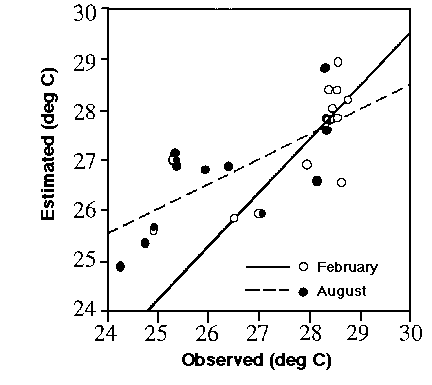
Figure PR-7. Comparison of observed equatorial Pacific sea surface temperatures (SST) with values estimated from foraminiferal assemblages in mixed layer net tows.
This difficulty in using transfer functions to make hindcasts can be expressed through the linked equations:
which can only be inverted to yield paleo-SST from assemblage data if F1 and F2 are constant over time. This is very hard to prove.
4. Carbon isotopic composition of foraminiferal tests. As with the oxygen isotopes, the carbon isotopic composition of the calcite tests of foraminifera, which will be discussed in more detail next week, depends on:
Even though continental glaciers do not have a direct impact on the carbon isotopic composition of seawater, the signals of oxygen and carbon isotopes resemble each other. In the case of carbon, however, the primary global glacial-interglacial signal is attributed to changes in the mass of the terrestrial biosphere. Plants preferentially take up 12C. Thus, during glacials, when the terrestrial biomass was greatly reduced (due, apparently, to reductions in the biomass of both temperate and tropical forests), the ocean was relatively depleted in 13C.
Note the del convention:
del13C(sample) = 1000 * (13C (sample) - 13C (standard)) / 13C (standard) (units of per mil)
Foraminifera metabolize C and use it to build protoplasm as well as calcite. Not surprisingly, therefore, vital effects are of much greater magnitude for carbon than for oxygen isotopes. Interspecific differences are large and often swamp the global signal. Because organic carbon is heavily depleted in 13C, surface waters in productive areas become enriched in 13C whereas regeneration (oxidation) of the 12C carbon in deep waters leads to progressive depletion in 13C as the waters get older and older.
As with oxygen, changes in lateral and vertical del13C gradients over time provide insights to the past behavior of the oceans. Figure PR-8 shows the percentage of North Atlantic Deep Water at 3500 m in the eastern North Atlantic west of Spain. This is calculated by a simple mixing model between a northern North Atlantic benthic record and one from the equatorial Pacific. The relative supply of NADW to this site was greatly reduced during glacial maxima.
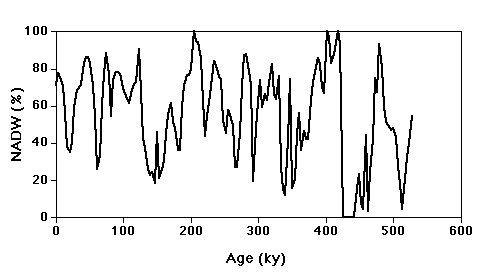
Figure PR-8. Estimated proportion of NADW at DSDP site 607 (eastern North Atlantic) based on fluctuations in the 13C content of benthic foraminifera (NADW water is 13C enriched).
Figure PR-9, on the other hand, is less easily explained. This plot shows the difference in benthic 13C between an Antarctic core and one from the equatorial Pacific. As expected from the general movement of bottom waters, the Antarctic today is enriched in 13C relative to the deep Pacific. During glacial times, however, the Antarctic is relatively depleted in 13C, a topic that we will return to later.
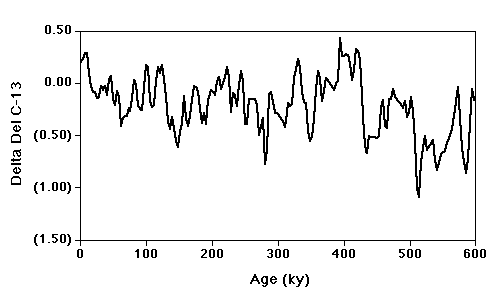
Figure PR-9. Del13C in benthic foraminifera from an Antarctic core relative to contemporaneous samples from an equatorial Pacific core. Both the secular trend and the negative glacial values are unexplained.
5. The flux of windblown dust (often identified by its quartz content, as we discussed in the first lecture) can be determined if the accumulation rate and bulk density of a core are known. Figure PR-10 shows that for the area off the Arabian peninsula, glacials were marked by high deposition rates of dust - an indication of enhanced supply or more capable monsoon winds (or both). Note the inverted scale and the clipping of the signal where values approach zero.
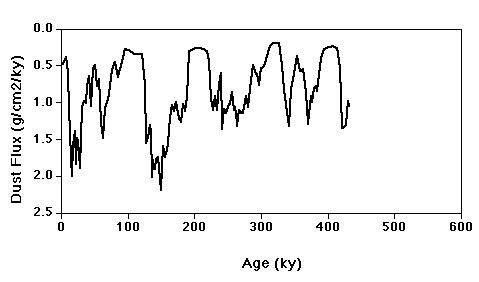
Figure PR-10. Flux of dust off the Arabian peninsula to core RC27-61. Note the inverted scale (low fluxes during interglacials).
6. The addition of carbon dioxide via the oxidation of organic matter to deep water as it "ages" (moves further from its source) results in increasing dissolution of foram tests and other carbonate particles. One indication of this dissolution is an increase in the proportion of fragmented foram tests. Figure PR-11 shows the variation in fragmentation down a core from the Caribbean, which is presently overlain by North Atlantic Intermediate Water. In this case, it appears that the overlying water was younger (less corrosive) during ice ages than it is today.
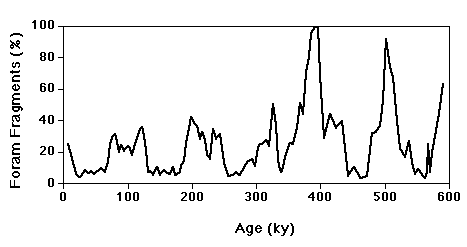
Figure PR-11. Percentage of foram fragments (a measure of bottom water corrosiveness) in Caribbean core P6408-9.
Broecker and Clark (1999; Paleoceanog. 14:596) have suggested that the percentage of carbonate >63 µm in a sediment sample is a direct measure of the pressure-normalized carbonate ion content of the bottom water (which they call CO3-2*) when the sediment was deposited.
CO3-2* = CO3-2 + 20 (4-h) µmol.kg-1
Where h is the water depth in km and 20µmol.kg-2 is the increase with water depth in the solubility of calcite. This is equivalent to normalizing all CO3-2 values to 4 km. Because of postdepositional fragmentation, the validity of this index earlier than the past few thousand years is still unclear.
7. Trace elements in foram calcite are in thermodynamic equilibrium with the seawater from which the calcite is deposited. The Cd/Ca ratio, which is highly correlated with the PO4-3 content of the water, and the Ba/Ca ratio, which appears to be related to biological productivity are discissed in future lectures. The Mg/Ca ratio incorporated in the tests appears to depend only on the water temperature (Figure PR-12; Lea et al., Science 2000, 289:1719).
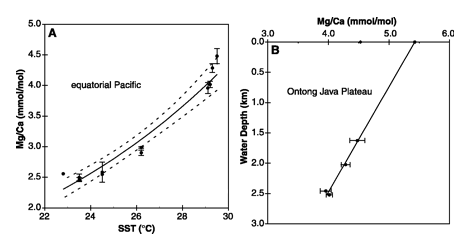
Figure PR-12. Effect of SST (A) and postdepositional dissolution (B) on the Mg/Ca ratio in the calcite tests of the foraminifera Globigerinoides ruber (from Lea et al. 2000, op. cit.)
Current analytical techniques allow temperature changes of less than 0.5ºC to be measured. Sea-floor dissolution preferentially removes Mg-rich calcite(Figure PR-12), so that data for fossil shells must be corrected to yield hindcast SSTs. By combining Mg/Ca and del18O data from the same samples, it becomes possible to separate the temperature and water composition components from the del18O signal.
When all the proxy information is put together (Figure PR-12), there is a high degree of internal consistency.
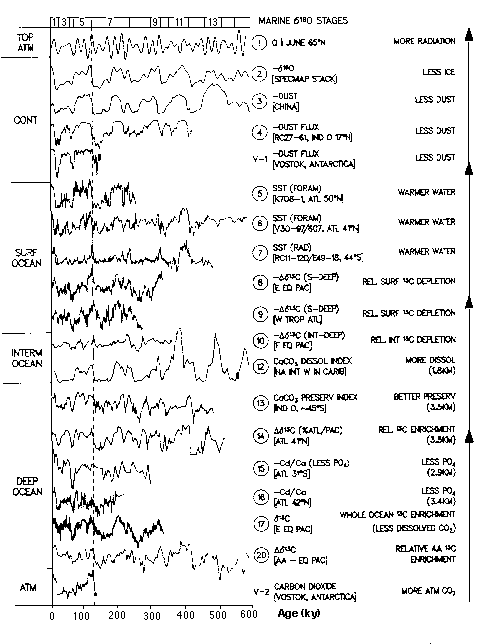
Figure PR-13. SPECMAP proxy data for the past 600,000 years, correlated by 18O records and showing the strong glacial-interglacial changes in all environmental variables.
The following changes occur during a transition from a glacial to an interglacial state:
The transition from an interglacial to a glacial state is more complex (Figure PR-13).
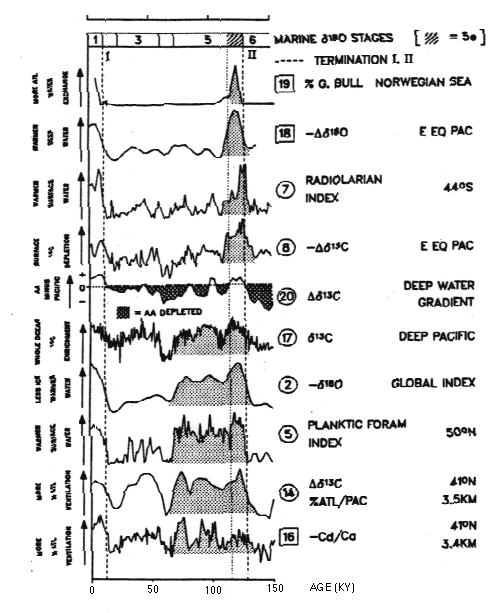
Figure PR-14. Patterns of climate change over the past 150,000 years. The signs of observations identified on the right are reversed as needed so that the interpretation of each time series has a positive upward sense of change toward an interglacial condition. For variable 20, for example, an upward shift in the curve means that deep waters in the Antarctic are becoming more 13C enriched than in the Pacific.
During the transition from the last interglacial (which began about 130,000 years ago) to the last glacial, all the proxies show a sharp onset of interglacial conditions (an event designated termination II, by analogy with termination I, the transition to the current interglacial), but some proxies indicate a brief (10-15 ky) interglacial, whereas others indicate a much longer (about 60 ky) warm period. The model developed to explain this paradox will be discussed after the proxy records have been revisited in the frequency domain.
|
Oceanography 540 Pages |